FISHING SOUTHERN CALIFORNIA’S BAYS AND HARBORS
Heading to one of the major Southern California urban areas for a business trip or a few days of R&R and looking for a place to wet a line for a few hours? Do you live in the region and need a winter alternative to the snowed in Sierra Nevada streams or lakes full of grumpy largemouth bass and bluegill? The answer to your search just might be the productive year-round fisheries of the bays and harbors of the left coast southland. Waters such as King Harbor, Long Beach Harbor, Newport Bay, Mission Bay, and San Diego Bay offer a diversity of environments with plenty of opportunities for quick outings or extended exploration. Many Southern California anglers have been introduced to flyfishing with sinking lines in the saltwater rather than freshwater with floating lines.
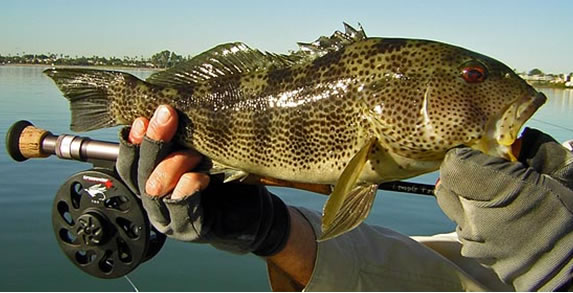
Southern California waters are populated with a host of target species. On my home waters of San Diego Bay and Mission Bay, I have caught more than 15 species and there are a few that have yet to be fooled by my offerings. The most common catch year round is the spotted bay bass, aka “Spottie”, a scrappy structure oriented fish that will readily take the fly. Spotties average about a foot long and one pound in weight and reach three pounds. Their determined battles often fool freshwater anglers more accustomed to trout, bass, and panfish into thinking that they have hooked something much larger. Other year round residents include barred sand bass and calico bass, both of which can reach 10 pounds, yellowfin croaker, corbina, halibut, juvenile white sea bass, sharks, and rays. Pelagic species such as pacific barracuda, bonito, and mackerel range into Southern California bays and estuaries in search of food. San Diego Bay has a year round population of shortfin corvina and even bonefish, a species that has been documented far north as San Francisco Bay in small numbers. Anglers learning about the presence of Southern California bonefish are often quick to enquire about flats fishing opportunities. Unfortunately that type of environment does not exist and the bonefish are typically incidental catches. Other catchable species include needlefish, lizardfish, back croaker, spotfin croaker, opal eye, and jacksmelt. Even clams, mantis shrimp, and octopi have come to the surface with a firm grip on a fly.
Getting on the Water
Southern California embayments may be fished afloat and afoot. Boats, kayaks, pontoon craft, and float tubes can all be used under appropriate conditions. Anglers using pontoon and especially float tubes must pay special attention to tides and currents. Even a small current of less than one mile per hour can be very difficult for a float tuber to overcome. Float tubes are best reserved for protected areas such as marinas and back bays or when a mother ship of some type is available. Pontoon craft propelled by oars offer greater mobility and are better for dealing with currents but should still be restricted to water were currents are light. Anglers using a float tube or pontoon craft should wear bright clothing and take other measures to ensure visibility to boat and personal water craft operators. Kayaks can be used to range over wide distances, are easy to transport, and can be launched from sandy beaches as well as launch ramps. Sit on top ‘yaks are most commonly used in Southern California waters and are often set up with multiple rod holders, depth finders, GPS units, handheld VHF radios, and other accessories. A boat is the optimal platform, offering the greatest range, speed, comfort, and safety. Most boats set up for freshwater angling suffice for adventures on the bay since the water is rarely rough. Boat and kayak rentals are available at several locations in Southern California. An internet search will turn up fly and light tackle guides who offer services on most area waters.
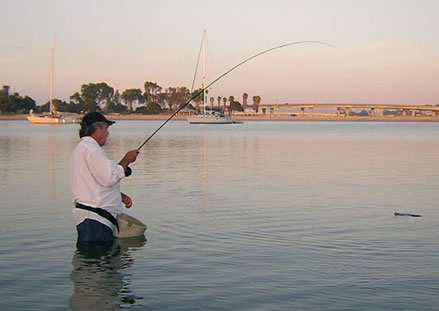
The shore bound angler will find accessible fishing in park and beach areas. These areas may be limited on some waters and more expansive on other. Shore bound and wading anglers need to remain aware of their surroundings to avoid hooking spectators, joggers, children, and others with their backcasts. Wading anglers should shuffle their feet to send the occasional stingray on its way. I have never heard of a wading angler being stung by a ray but the possibility exists. Shuffling will also help you detect unseen holes before stepping into them.
Fly tackle for Bay and Harbor Fishing
Fly casters plying the waters of southern California embayments and harbors typically use four through nine weight rods. A seven weight rod a good all around choice. A six weight and an eight weight would be a perfect pair of rods and a four weight is fun for jacksmelt. Most fish will run less than three pounds but there is always a chance of hooking up with a big ray, a good size bonito, a hefty bass, or wide halibut so it is nice but not essential to have a rod with a bit of muscle in the butt section. Choice of rod length is a personnel preference. I prefer seven and a half to eight foot rods when fishing from a kayak and nine foot rods when on foot or in a boat. Some anglers employ 11 foot and longer rods for overhead casting when fishing from shore or wading.
A premium fly reel is not necessary for this type of fishing. Most of the local species do not make long runs. Even the local bonefish tend to make shorter runs with lots of direction changes. Bonito are usually the hottest fish encountered and the smaller examples typically found in the bays rarely run more than 50 to 75 yards. A big ray may take a couple of hundred yards of backing if you have it, but the pace is often more methodical rather than blistering, though they can get really moving at times. A good quality click and pawl reel will work as will just about any disc drag model if properly cared for. Many of the inexpensive graphite composite reels on the market are popular due to their simple maintenance requirements. Avoid magnesium frame reels that will corrode quickly in saltwater. A hundred yards of backing is more than enough most of the time. An angler purchasing their first rig can put together a suitable outfit for less than $150. One example setup would consist of a Scientific Anglers Bass or Saltwater starter combo (~$110) with 7/8 weight rod, Concept 58 reel, and floating line supplemented by a Teeny Basic Sink BS-200 line (~$35).
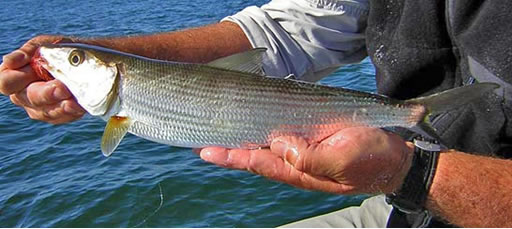
For much of your bay and harbor fishing you want to present your fly near the bottom so some type of sinking line is often preferred. You want to be prepared to fish depths of zero through 25 feet. Fast sinking lines will help get the fly down near bottom structure in deep water and even in shallow areas when tidal currents are strong. When species such as bonito, mackerel, and barracuda are found higher up in the water column the faster retrieve that is often most effective with keep the line nearer to the surface. Sink tip lines with sinking sections of 15 feet or less can be used in shallower water when currents are minimal but lines with sinking sections of 20 feet and longer are more effective at keeping the fly deep throughout the retrieve. Interchangeable shooting head systems or integrated lines like Teeny T or TS series, S.A Streamer Express, Orvis Depth Charge, Cortland Quick Descent, Rio Outbound, Airflo Depthfinder and similar lines are used by most anglers. These lines are also ideal for casting long distances and can be purchased with different sink rates. The ability to toss a long line, though not essential will keep your fly fishing longer.
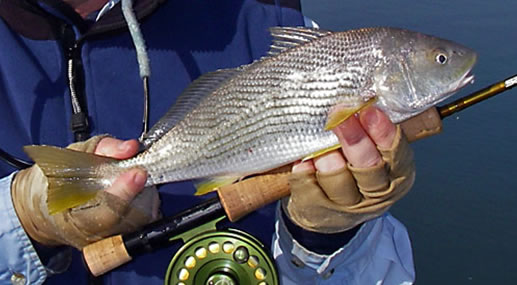
I like to have three rigs available when fishing from a boat or kayak. The first is a rod set up with a slow sinking intermediate line for working depths of four to ten feet. This rig can also be used for presentations to fish busting bait on the surface and even works well for casting surface patterns like crease flies and poppers. I have found no difference in hookup rates between clear or opaque intermediate lines. My second rig is set up with a line sporting a sink rate of about four inches per second. This setup is used for waters up to about 15 feet deep and is useful even in shallow waters when the current is too strong to effectively get the fly down with an intermediate line. The third rod is rigged with a line with a seven to nine inch per second sink rate and is used in waters 10 to 30 feet deep. Leaders can be simple. A level leader made from four to eight feet of your favorite 6 lb. to 12 lb. monofilament will suffice most of the time. Some anglers will prefer a tapered leader for surface presentations with an intermediate line.
A fourth rig setup with a floating line comes in handy when fishing the beach areas of the bay afoot from the shore, wading, working shallow the eel grass or mud flats from a boat, and when casting surface patterns to corvina or bonito busting up bait balls. Tropical fly lines are not necessary on Southern California waters since they are usually too stiff the cool to temperate waters. I use a standard freshwater weight forward line complemented with a tapered leader running from 12 to 20 feet. The purpose of the long leader is to keep the fly away from the end of the flyline which may spook fish in shallow water. It also allows you to get the fly deeper with a floating line. An intermediate line can be useful to the walking angler if there is a breeze on the water since it will settle below the surface current, avoiding the introduction of a windblown bow in the line that can impair strike detection.
Angling Accessories
When fishing from shore anglers will benefit from the use a stripping basket of some sort to maintain control of your flyline and avoid rocks, mud, and sand. Most locals wear stocking foot waders with dive or float tube booties when wading during the fall, winter, and spring. Conventional wading boots or boot foot waters are fine too. Even during the summer, when water temperatures reach 70° F, the typical night and morning marine layer and accompanying breeze can lead to a chill so some anglers stick with waders in the summer too. Many are comfortable wading wet at this time as I often do. A gripping device such as a Boga Grip or Lippa4Life can be used to safely grab the jaw of a toothy fish so that a fly can be removed. It is not necessary to lift the fish from the water, just secure it for a quick hook removal and clean release. Forceps or pliers can assist with hook removal. If angling from a watercraft an electronic depth finder will prove almost indispensible for identifying potentially productive areas and eliminating less productive water. Navigational charts, either in paper or electronic form, will provide clues for locating fish and help keep you safe on the water. A drift sock or drogue chute will help slow down a wind drift of a boat or kayak.
Filling the Fly Box
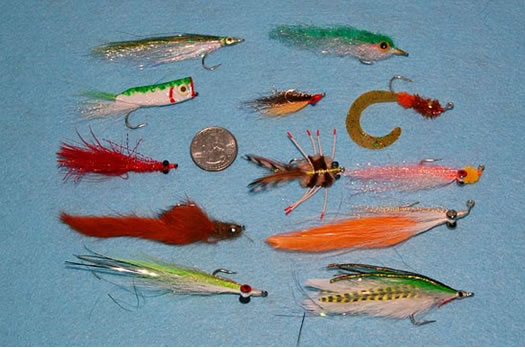
The target species are for the most part not particular to specific patterns. If all you had was a box of chartreuse/white clouser minnows tied on size 4 hooks, you would catch plenty of fish. Local forage for game fish includes shrimp, crabs, marine worms, clams, and various bait fish species. A general rule of thumb is that flies on size 2, 4 or 6 hooks will be more productive. Larger flies seem to be more likely to draw grabs by larger fish. I rarely use any fly more that 3" long in our local bays and harbors; however, I will go larger when I see evidence of gamefish working larger baitfish. Besides clouser minnows, any type of small streamer pattern will work, as will most types of crab patterns and bonefish flies. Flies with some orange incorporated do quite well. The orange color imitates the row sacs of many crab species. One of my favorite patterns consists of a rust colored rabbit strip, a few strands of flash, dumbbell eyes and a hook. The fancy version has some rust or orange colored chenille wrapped around the eyes. Perhaps it imitates a marine worm. I don’t know for sure, but the fish sure eat it. Many local anglers have developed their own special patterns, but most are variants of widely available flies. Even the wooly buggers in your trout fly collection can be very effective. A handful of small Blados crease flies, Gartside gurglers, or foam poppers are handy to have along when surface action opportunities arise. When I put together a fly box for an outing on a bay rather than focus on specific fly patterns I just ensure sure I have a collection flies from un-weighted to heavily weighted patterns in a variety of colors, sizes, and shades ranging from light to dark.
When To Fish
The single most important factor for identifying optimal fishing times is the tidal phase. Fishing can be productive at any point during the tide; however better angling will generally occur when there is some tidal current. Some locations may produce better with strong currents and others with slower currents. Experience on the water will help narrow down the ideal conditions for each location. But without that experience, a bit of observation can still identify likely spots. Currents create their own dynamic structure that changes continually throughout the tidal phase. These structures are the current seams created down current of hard structure, or even in open water where faster and slower currents meet. These can often be found visually by looking for something as obvious as an abrupt change in water color, mud plumes, or even by observing how sea birds are drifting on the water. These current seams are often a good place to start looking for fish in the absence of other information. It is not unusual to find that one side or the other of a current seam is more productive.
The wind will usually come into play at some time during the day. Throughout the year, mornings will often be calm but the breeze will begin to build as the day progresses. There are plenty of exceptions though; sometimes the wind blows all day or on others it may taper off in the afternoon. The wind can be our friend, pushing a boat along for a slow drift to cover the water. It can also be environmental aggravation making boat control challenging and fly casting difficult to dangerous.
Fishing at night can be as productive as during the day. The prevailing afternoon winds often lay down following sunset, providing a great opportunity for an angling session after a day at the office. In urban areas like San Diego, the views of the illuminated skyline provide a colorful backdrop.

These waters fish well throughout the year and most of the species are present year round. Productive tactics and locations remain the same regardless of the label on your calendar page. During the winter when the water cools, faster presentations of the fly are less likely to be productive and pelagic species like bonito and barracuda are less common. Though the angling tends to be more productive during the warmer seasons, the biggest difference between winter and summer angling often comes down to the difference in the number of layers of clothing worn by the angler.
Locations and Tactics
Perhaps the easiest areas to fish successfully are eel grass flats in three to twelve feet of water. Though fish can be found here at any time he grass flats tend to produce best during the second half of the incoming and first half of the outgoing tide when game fish move onto them in greater numbers in search of food. Spotted bay bass and other species fish will be lying right in the grass waiting to intercept baitfish and crustaceans being swept by the current. Fish will also be found on edges of the flats. The fish are often very aggressive during this stage and strikes will often be jolting. Often I've had my running line ripped from my hands when my mind wandered. You need remain alert though, since some takes will be light; nothing more than a loss of contact with the fly. Although strikes will often come on the sink, I always cast with the goal of getting the fly right down to the grass. If I am not occasionally bringing up some salad I am not swimming my fly deep enough.
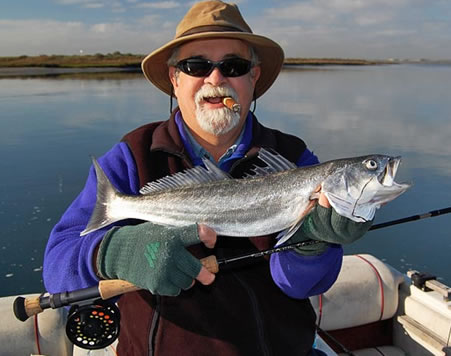
I usually drift with the wind and the current over the flats, searching for schools of fish. Casts can be made the direction of the drift, perpendicular to the drift, or anywhere in between depending on the depth of the water and speed of the current. If I anchor up, I will place the boat over the flats near a channel edge where the current is running parallel to the channel. In this situation I make a quartering cast up-current and just beyond the edge. I then let the fly sink and sweep along the edge, retrieving just enough line to maintain contact with the fly. Strikes will occur as the fly drops over the channel edge and is swept along in the current. When walking the shoreline or wading, I will continually move along making casts every few feet until I find fish.
While open eel grass flats may provide the easiest fishing, visible structure provides the most obvious fishing locations. Within the developed bays of southern California such structure is usually man-made: rock retaining walls, breakwaters, jetties, piers pilings, docks, moored boats, bridges, and wrecks. I find it difficult to pass up making a few casts to such structure until I determine a particular item is generally unproductive. More often than not they are productive at some point during the tidal sequence. Fish are often found tight to such structure during slack water periods but move off some when there is some current. Fishing around visible structure often produces the greatest variety of species during an outing as numerous game fish are drawn to the baitfish using it as cover. When casting to visible structure I usually count my fly down to the bottom, perhaps interjecting a strip or two, while remaining attentive for light strikes. If the fly reaches my predetermined count (depth) I will then commence a full retrieve. Many strikes come on the sink or after the first couple of strips. The shore bound angler fishing from a jetty or rock wall without backcast room can employ the saltwater equivalent of high stick nymphing. Just make a short roll cast up-current with a fast sinking line and weighted fly and follow the fly as the current carries it along with rod tip.

Channels edges are perhaps the most consistently productive areas to fish. Maps intended for marine navigation along with depth finders will help locate the smaller channels. Major channels leading into and out of bays and marinas will be revealed by navigational markers delineating safe zones for deep draft craft. These transition points between deep and shallow water almost always hold fish, even during slack tide periods, and serve as staging areas for fish preparing to move onto the flats to feed. The angling along channel edges is often at its best when the tide first starts to push up onto the adjacent grass or mud flats and again near the latter part of the ebb. The ideal way to work a channel edge is to drift along parallel to the edge or work along it with an electric trolling motor. This will allow the angler to continuously work the fly along the edge. If wind and current dictate a drift perpendicular to the edge, be sure to have your fly in the water as the edge zone is crossed.
Effectively fishing deep water can be challenging for the fly angler. The conventional angler can use lead head jig heads to get his lure down but the fly angler has to rely on sinking lines and drift management to score consistently. Some channels will be fifty feet or deeper but fortunately we do not usually have to resort to fishing this deep. Hungry fish will move up in the water column to feed on schools of baitfish as they move through with the tides, often right to the surface. Although large bass and halibut can be hooked near the bottom of the center of the channel, the deep edges are usually a better bet. This typically means fishing in water 15 to 30 feet deep. For the deepest presentations it is often necessary to cast a fast sinking line down drift (ahead of the drifting boat) in order to allow time for the line to sink without any tension before the boat passes it's entry point and begins to drag it upward out of the strike zone. Depending on the desired depth, the retrieve can be initiated at any point at or beyond where the fly entered the water. I have hooked fish at depths up to 50 feet using this method.
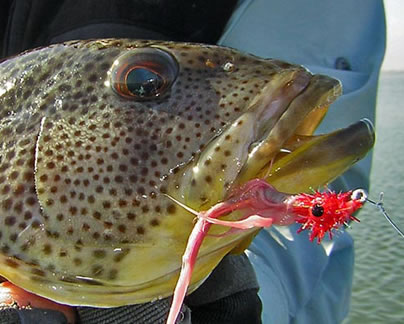
Marinas and anchorages provide structure and cover that attract both predators and prey. Casts to pilings, docks, mooring gear, and alongside boats often are rewarded with jarring strikes. Do be careful with your casts through. You do not want to hang your backcast in a moored boat’s rigging or chip the gel coat on someone’s hull.
Finally, bait receivers are worthy of the angler’s attention. Constructed and operated to service the general public and the sport fishing fleets, bait receivers attract all sorts of wild life looking for an easy meal from spilled or discarded bait. This includes birds, sea lions, and game fish. Sometimes cold, sometimes hot, it is usually worth your time to make a few casts around the receivers - you never know what you might hook up.
Putting it All Together
Your bay and harbor adventures can be a simple or extensive as your time and inclination warrant. These waters offer an opportunity for novice fly anglers to have successful initial outings, yet hold the promise of years of exploration by the experience angler. Your gear doesn’t have to be pricy and you do not need a lot of it. You can make a few casts just about any time and have a chance for success. The nuggets of information presented here are just a starting point; a guide to help the angler new to these waters, whether a local new to the salt or a visitor looking for a way to spend a few hours or a day, prepare for an adventure on unfamiliar waters. As you spend more time on the water you will develop your own preferences for gear and flies, discover new tactics, and develop a feel for the effects of tides and winds.
Don’t forget to take a look around, above and below, while you are fishing. You may see an osprey or two over head, a kingfisher sitting on a post, a sea turtle poke its head out of the water, a heron trying to figure out how to eat a fish that’s too big for its open beak, or a colorful jellyfish drift lazily by. Oh, and if you happen to see birds diving into the water, you might just want to get closer and check out the commotion.
